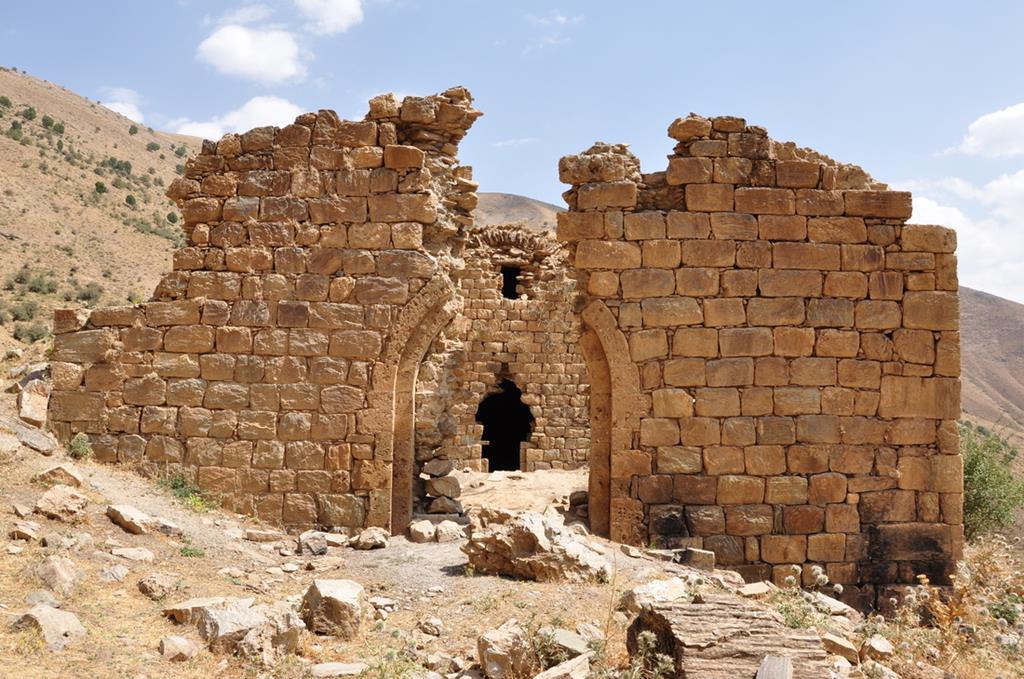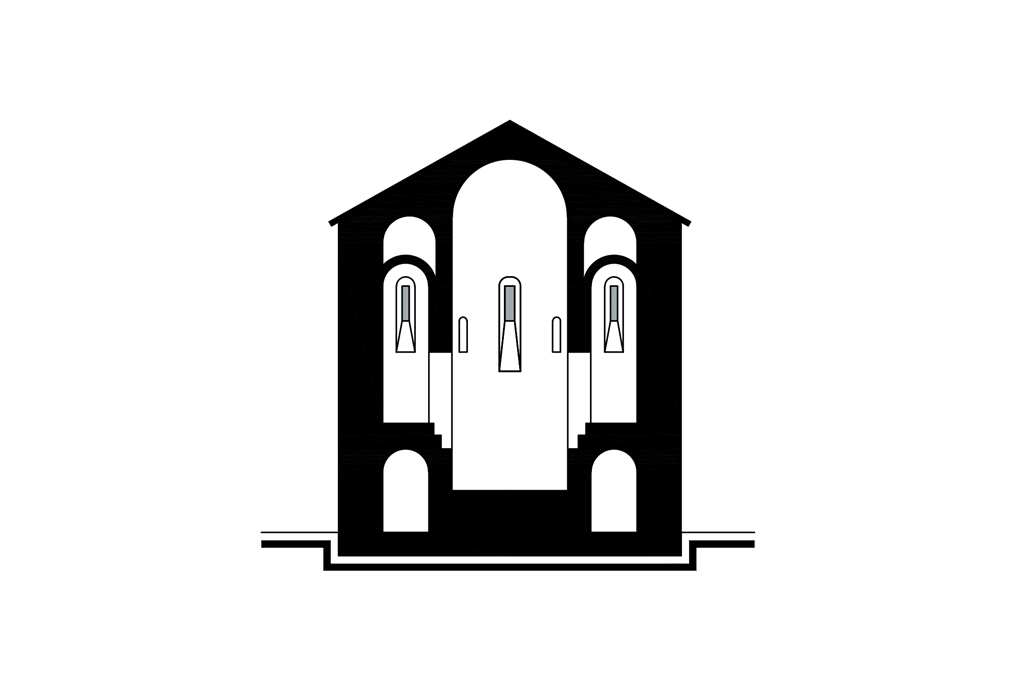Southwest of Mogs [Bahçesaray], at 38°06’ N and 42°46’ E, where a small valley branches off from the larger valley of Arwanitz Tzor [Delan Dere] at an altitude of 2200 m, near the village of Spgants (Sourp Ganants) [Elmayaka], which borrows its name, stands the monastery of the Holy Women or church of the Holy Cross of Mogs, also called Dzayad.
The holy women to whom the convent is dedicated are a community of Christian women, led by the virgin Hrip‘simé, who fled the Roman Empire at the time of Diocletian’s persecutions and took refuge in Armenia. The martyrdom of these holy women at Vagharchabad (Edchmiadzin) at the end of the 3rd or beginning of the 4th century is closely associated with the preaching of Saint Gregory the Illuminator and the conversion of the Kingdom of Armenia to Christianity under the reign of Tridatès IV (Drtad). The account of their travels in Armenia was set down in the 9th century in the Story of Hripsimé and the Holy Women. The story takes them first to Mount Sebouh [Kara Dağ], in upper Armenia, where one of the women settled and where Saint Gregory would go to spend the rest of his life (see n° 45). After several stopovers in different regions located to the south and southeast of Lake Van, the women end up, before their martyrdom, at mount Varak (Erek Dağ, see n° 1). The story claims that, in Moxoene – province of Mogs – Saint Hrip’simé built a chapel in a place dedicated to the Holy Cross. Tradition says the chapel goes back to the foundation of the monastery of the Holy Cross of Mogs or the Holy Women. Their passage marked other places, like the convent of Kineganits or Knigonits Vank‘, founded near by on the tomb of Saint Kiné, one of Hrip‘simé’s compagnons who died there, or the convent of the Holy Mother of God of Gdjav, situated south of Mogs.

Façade ouest du narthex et de l'église, 2013 (Coll. George Aghjayan).
Founded before the writing of the Story of Hripsimé and the Holy Women, the monastery of the Holy Women was the original community of Catholicos Ananias I of Mogs (Anania Mogatsi, 946-968), fervent defender of Armenian Church doctrine against Chalcedonian influences. It was mentioned as a scriptorium in 1380, under Abbot Diratsu, then in 1401 under the doctor, Thomas (T‘ouma). In all likelihood it was the brother of the latter, Gregory (Krikor), Bishop of Mogs, who restored the monastery church in 1408. The production of copies continued to be attested in the 16th century, in 1579 and 1586, a time when the monastery was still very active, as is suggested by a cemetery cross bearing the date 1559 and another from 1592, inserted in the east façade of the church. The church was then rededicated – to the Holy Precursor (Sourp Garabed) – after having received the relics of John the Baptist and Saint Athenogenès, which certainly came from Darôn. In 1749, these relics would be placed in a reliquary commissioned by Gregory of Hir (Krikor Hirétsi), perhaps a monk of the convent or the priory of Hir, located further up the valley of Arwanits Tzor (Hiravank‘). In the 19th century, many of the monastery’s properties were taken over by bey sbefore the prior, Arsen, managed to restore it to prominence.

Plan (Thierry, 1989, 415).
The monastery of the Holy Women includes:
•The church of the Holy Cross or the Holy Precursor: a single nave with three apses and a saddle roof, 11.8 × 7.3 m with ribs and lateral niches under arches; probably built in the 8th century and restored in 1408; the central apse has a single-level synthronon and steps on either side of the altar leading to raised lateral chambers set above vaulted spaces.
•A narthex measuring 13.6 × 10.7 meters built later in front of the old church, resting on four central cruciform columns that frame a compartment covered by a vaulted roof and, on the sides eight vaulted compartments;
•Commons;
•A cemetery.
The monastery owned arable land, pastureland and woods.

Transversale section of the absidial block (Thierry, 1989, 415).
The monastery of the Holy Women or the Holy Cross of Mogs was confiscated after the Great War and abandoned. In the 1970s, the commons had disappeared, but the church and narthex were still standing. Since then they have continued to deteriorate. In 2009 half of the narthex had collapsed, and in the east façade, which was still standing, a break runs from the top of the wall cutting through the arch of the portal. The covering slaps of the church have disappeared, leaving bare the sides of the vault. Of all of the monastery’s possessions, only the right hand of the Precursor was saved, carried away by the survivors of 1915 when they fled to Bassorah.
Oskian, 1940-1947, III, [1947], 866-870. Achdjian, 1970, 185-189. Thierry, 1989, 413-417. Outtier, Thierry, 1990, 695-733. Devgants, 1991, 174.